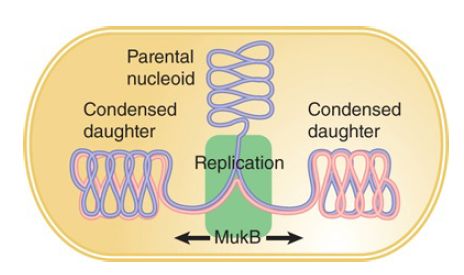
Partition Involves Separation of the Chromosomes
 المؤلف:
JOCELYN E. KREBS, ELLIOTT S. GOLDSTEIN and STEPHEN T. KILPATRICK
المؤلف:
JOCELYN E. KREBS, ELLIOTT S. GOLDSTEIN and STEPHEN T. KILPATRICK
 المصدر:
LEWIN’S GENES XII
المصدر:
LEWIN’S GENES XII
 الجزء والصفحة:
الجزء والصفحة:
 31-3-2021
31-3-2021
 2726
2726
Partition Involves Separation of the Chromosomes
KEY CONCEPTS
-Daughter chromosomes are disentangled from each other by topoisomerases.
-Chromosome segregation occurs concurrently with DNA replication; that is, it begins before DNA replication is finished.
-Condensation of the chromosome by MukBEF or SMC proteins is necessary for proper chromosome orientation and segregation.
Partition is the process by which the two daughter chromosomes find themselves on either side of the position at which the septum forms. Two types of event are required for proper partition:
- The two daughter chromosomes must be released from one another so that they can segregate following termination. This requires disentangling of DNA regions that are coiled around each other in the vicinity of the terminus. Mutations affecting partition map in genes coding for topoisomerases—enzymes with the ability to pass DNA strands through one another. The mutations prevent the daughter chromosomes from segregating, with the result that the DNA is located in a single, large mass at mid-cell. Septum formation then releases an anucleate cell and a cell containing both daughter chromosomes. This tells us that the bacterium must be able to disentangle its chromosomes topologically in order to be able to segregate them into different daughter cells.
- The two daughter chromosomes must move apart during partition. The original models for chromosome segregation suggested that the cell envelope grows by insertion of material between membrane-attachment sites of the two chromosomes, thus pushing them apart. In fact, the cell wall and membrane grow heterogeneously over the whole cell surface. Current models of bacterial chromosome segregation do not require attachment to the membrane, although the confinement that is provided by the membrane is thought to be necessary to help push chromosomes apart. Some of the machinery and forces that drive segregation have been identified but the picture is still incomplete. The first important step is to promote separation of the newly replicated origin regions of the chromosome. As new origins move to new cellular locations , the rest of the chromosomes follow after they are replicated. The replicated chromosomes are capable of abrupt movements, which indicates that some regions are held together for an interval of time before they rapidly separate. The final step is to separate newly replicated terminus regions of the chromosome.
Mutations that affect the partition process itself are rare. Segregation is interrupted by mutations of the muk class in E. coli, which give rise to anucleate progeny at a much increased
frequency: Both daughter chromosomes remain on the same side of the septum instead of segregating. Mutations in the muk genes are not lethal, and they identify components of the apparatus that segregate the chromosomes. The gene mukB encodes a large (180-kD) protein, which has the same general type of organization as the two groups of structural maintenance of chromosomes (SMC) proteins that are involved in condensing and in holding together eukaryotic chromosomes. SMC-like proteins have also been found in other bacteria and mutations in their genes also increase the frequency of anucleate cells. Another phenotype of mukB mutants is that the organization of the chromosome is altered from that ; origins and termini are reoriented toward the poles for the entire cell cycle. Therefore, MukB also acts to properly orient and position the origin regions of the chromosome during segregation.
Initial insight into the role of MukB was the discovery that some mutations in mukB can be suppressed by mutations in topA, the gene that encodes topoisomerase I. MukB forms a complex with two other proteins, MukE and MukF, and the MukBEF complex is considered to be a condensin analogous to eukaryotic condensins. A defect in this function can be compensated for by preventing topoisomerases from relaxing negative supercoils; the resulting
increase in supercoil density helps to restore the proper state of condensation and allow segregation. FIGURE 1 shows one model for the role of condensation. The parental genome is centrally positioned. It must be decondensed in order to pass through the replication apparatus. The daughter chromosomes emerge from replication, are disentangled by topoisomerases, and then passed in an uncondensed state to MukBEF, which causes them to form condensed masses at the positions that will become the centers of the daughter cells.

FIGURE 1. The DNA of a single parental nucleoid becomes decondensed during replication. MukB is an essential component of the apparatus that recondenses the daughter nucleoids.
It is likely that MukBEF (or SMC in other bacteria) works with other factors to promote the initial steps in segregation of the origin region of the chromosome. Researchers have identified some of these factors in other bacteria, such as partition genes, called parA and parB, that resemble those necessary for partition of low-copynumber plasmids. These discoveries and analyses in current research will lead to a better understanding of how genomes are positioned in the cell.
 الاكثر قراءة في مواضيع عامة في الاحياء الجزيئي
الاكثر قراءة في مواضيع عامة في الاحياء الجزيئي
 اخر الاخبار
اخر الاخبار
اخبار العتبة العباسية المقدسة


